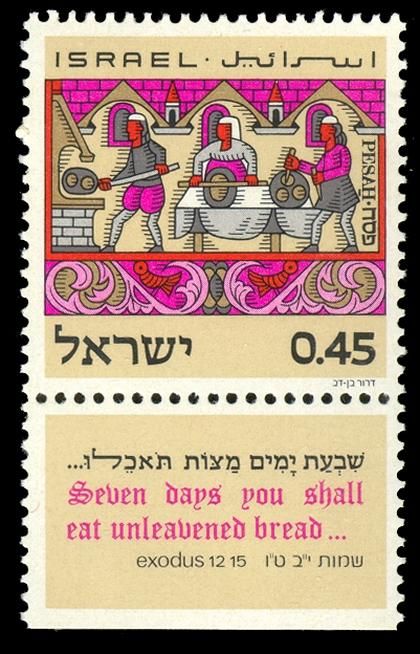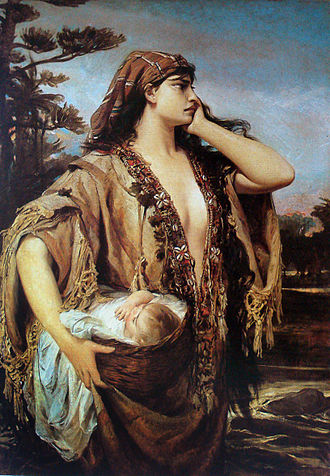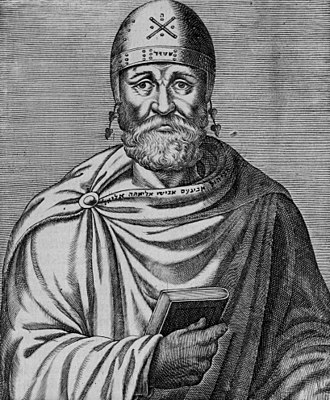This d’var Torah originally appeared on Rabbi Maurice Harris’ Substack newsletter. Read more here.

On the first day of Passover the tradition is for Jews to read verses from the Torah depicting a tense scene in the slave ghettos of Pharaoh’s Egypt just before the arrival of the 10th and final plague, the slaying of the first born of Egypt. Moses calls together the elders of the people and says to them, “Go, pick out lambs for your families, and slaughter the Passover offering. Take a bunch of hyssop, dip it in the blood that is in the basin, and apply some of the blood that is in the basin to the lintel and to the two doorposts [of your homes]. None of you shall go outside the door of your homes until morning. For when the Eternal goes through to smite the Egyptian first born sons, God will see the blood on the lintel and the two doorposts, and God will pass over the door and not let the Destroyer enter and smite your home.” (Exodus 12:21-23)
In recent years, much has been written about how the Passover story begins and ends with birth imagery. In the Reconstructionist movement’s Haggadah, A Night of Questions, we read the following (and I paraphrase):
How was the desire for freedom first aroused? By the midwives, Shifrah and Puah, who resisted Pharaoh’s decree to kill every Israelite boy. By Miriam, who watched over her brother Moses to insure his safety as he floated in a basket down the Nile. … In the birth waters and in the Nile, these extraordinary women saw life and liberation. … The waters of freedom open and close the Passover story, taking us from the Nile to the Sea of Reeds.
A baby, Moses, is given life thanks to brave midwives and then pulled from the water by a princess. The birth imagery is striking. This is the beginning of the Passover story. At its end, a nation-being-born passes through the narrow cavity of the path that God opens through the Sea of Reeds and then emerges out the other side, alive and free. Birth imagery again.
We find yet more birth imagery here in the middle of the story, in the verses we will read the first morning of Passover. It shows up again at this crucial moment, just before the 10th plague brings grief and sorrow to so many in ancient Egypt, just before the Pharaoh finally summons Moses and Aaron and spits out the words, “Up, depart from among my people, you and the Israelites with you. Go, worship the Eternal as you said! Take also your flocks and your herds, as you said, and begone! And may you bring a blessing upon me also!” (Exodus 12:31-32)
In the moment when Moses instructs the Israelites to take a lamb, slaughter it as an offering, put its blood in a basin, and then paint the blood on the top and on the side posts of the doors of their homes, we are confronted yet again with a visual image of a people getting ready to pass through a kind of bloody birth canal, out of a holding chamber and into a new existence.
The Torah is full of literary links that tie together thematic echoes across texts. The text that describes the placing of the lamb’s blood on the slaves’ doorposts offers us one of these marvelous literary links. The key word is the Hebrew word for basin — saf — spelled with a samech and a final fay. This is the basin that Moses tells the people to put the lamb’s blood in, out of which they will take up the blood to paint it on their doorposts.

Saf is a somewhat unusual word, and it calls our attention to a key word in the other two moments of birth imagery that I’ve mentioned. In the first instance, which describes baby Moses being placed into the Nile and then drawn out of the water by the Pharaoh’s daughter, the text tells us that Moses’ mother placed the basket containing her beloved child in the reeds of the river. The Hebrew word for reeds is soof, spelled almost identically to saf. In the second instance — the liberation of the Israelites after they cross the divided Sea of Reeds — the word soof appears again, this time as part of the name of the body of water from which they emerged.
Let’s take a closer look at these little Hebrew words, saf and soof, and see what other connections emerge. Let’s also expand our examination of the birth imagery that is so present throughout this story. When we do, we find elements, or at least hints, of death, blood and rebirth in all three of these key moments in the story.
The Torah is full of literary links that tie together thematic echoes across texts.
Rabbi Maurice Harris Tweet
At the beginning of the Passover tale, Moses is a baby marked for death. When his mother and sister send him afloat upon the Nile, they give him over to almost certain death. Listen to how the ancient Jewish philosopher, Philo of Alexandria (20 BCE‒50 C.E.), retells this moment of the story in his book, On the Life of Moses.
Moses’ parents … with many tears exposed their child on the banks of the river, and departed groaning and lamenting, pitying themselves for the necessity which had fallen upon them, and calling themselves the slayers and murderers of their child… Then, as was natural for people involved in a miserable misfortune, they accused themselves as having brought a heavier affliction on themselves then they need have done. “For why,” said they, “did we not let him die as Pharaoh ordered at the moment of his birth? But we, in our affection, have nourished him these three entire months, causing ourselves by such conduct more abundant grief, and inflicting upon him a heavier punishment, in order that he, having at last attained to a great capacity for feeling pleasures and pains, should at last perish in the most grievous of evils.” And so they departed in ignorance of the future, being wholly overwhelmed with sad misery.

So as we see, the story of the rescue and adoption of baby Moses is fraught with the potential of death. It also offers us a scene with its own unique moment of birth imagery when the Pharaoh’s daughter sees the helpless baby and has compassion on him, drawing him out of the waters and taking him for her own. Let’s listen to Philo’s interpretive telling of this moment as well:
Now the king of the country had an only daughter, whom he tenderly loved, and they say that she, although she had been married a long time, had never had any children, and therefore, as was natural, was very desirous of children. … And as she was always desponding and lamenting, so especially on that particular day was she overcome by the weight of her anxiety, that, though it was her ordinary custom to stay indoors and never to pass over the threshold of her house, yet now she went forth with her handmaidens to the river, where the infant was lying. And there, as she was about to indulge in a bath and purification in the thickest part of the marsh, she beheld the child, and commanded her handmaidens to bring him to her.
Philo also adds a story that, after keeping the baby a while, she faked a pregnancy, stuffing things into the abdomen of her clothing in order to create appearances of having birthed the child herself. If we assume that Philo was relaying folklore or possibly early oral midrash in his elaborations on the story we find in the Torah, which mentions very little about the Egyptian princess, her feelings or her back story, then we see one of the most well-known birth motifs found in the Hebrew bible being attributed to the Egyptian princess — the agony of being unable to conceive a child and the arrival of a miraculously unexpected child to solve the problem.
I think there’s blood imagery here, too, though it’s only hinted at. Later, during the 10 plagues, the Nile will be turned to blood. But also in this story, reading between the lines, it may be that the Pharaoh’s daughter was heading to the Nile to purify herself ritually following her menstrual cycle. If so, then Moses’ arrival represents a miraculous reversing of a lack of conception and birth.

When we look at the Torah verses that tell the story of the 10th plague and the angel of death passing over the homes of the Hebrew slaves and slaying the first born of the Egyptians, we also see a story that presents us with death, with blood and with birth. The vividness of the lamb’s blood in the basin — the saf — being painted on the doorposts and lintels is there; these are like birth canals the Israelites will pass through after the destroying angel has passed over them.
And finally, in the closing part of the Passover story — the marching through the miraculously divided Sea of Reeds, there are once again hints of death, blood, and images of birth. The word for “reeds” – soof bears close resemblance to the Hebrew word for “end,” which is sof. The Yam Soof, the Sea of Reeds, is also a pun for what the Israelites are afraid it really will be for them, namely the Yam Sof — the Sea of their End, their deaths. And with the Egyptian chariots pressing in on them, the death they are terrified they are about to experience is going to be a bloody one.
But then the Sea of Death turns into an unexpected birth canal, and when the people march across the sea to freedom and then the sea closes in and drowns the Pharaoh’s armies, the violent birth of this nation is complete. And on either side of the sea, we find two lone figures with the strangest of relation to the newborn. The Pharaoh, a maternal grandfather of sorts to Moses, stunned and defeated on one side, and Miriam, biological sister to Moses and therefore just on the cusp of being a granddaughter to Pharaoh, leading the women in dance on the other. A defeated, would-be god-on-earth on one side. A prophetess of the God Who Has No Name on the other.
And to all who will be celebrating holy seasons of various faith traditions in the weeks ahead, may they inspire all who celebrate to shine brilliantly with compassion, courage and lovingkindness.
Rabbi Maurice Harris Tweet
Death, blood, birth. It’s there throughout this story.
I’d like to close with one last image, also from Philo. Philo lived in the Jewish community of Alexandria in Egypt about 2,000 years ago, and his life’s work involved harmonizing Greek philosophy and Torah. What I’d like to leave you with is his explanation of the allegorical meaning of the burning bush miracle, later in Moses’ life, when he finds himself upon Mount Sinai, tending his father-in-law’s flocks, and sees a scrub brush bush on fire but notices that the little bush isn’t being consumed by the flames. Here is what Philo wrote about this:
For the burning bush was a symbol of the oppressed people, and the burning fire was a symbol of the oppressors; and the circumstance of the burning bush not being consumed by the fire was an emblem of the fact that the people thus oppressed would not be destroyed by those who were attacking them, but that the oppressors’ hostility would be unsuccessful and fruitless to the oppressed. This bush — the briar — is a most weak and supple plant. … It was not consumed by fire, but on the contrary it was preserved by it. … All of this is an allegory … almost crying out in plain words to persons in affliction, ‘Do not faint; your weakness is your strength. You shall be saved rather then destroyed … so that you shall not be overwhelmed by the evils with which they afflict you, but when your enemies think most surely that they are destroying you, then you shall most brilliantly shine out in glory.’
For those who celebrate it, blessings as we draw closer to Pesach! And to all who will be celebrating holy seasons of various faith traditions in the weeks ahead, may they inspire all who celebrate to shine brilliantly with compassion, courage and lovingkindness.
Rabbi Maurice Harris is Associate Director for Thriving Communities and Israel Affairs Specialist at Reconstructing Judaism.







